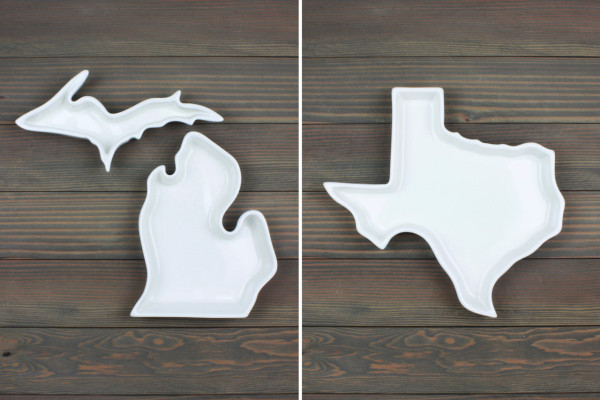Last year, we heard about Corbé, a design studio in Detroit making handcrafted modern ceramics that are inspired by a combination of mid-century design, traditional craft, and American manufacturing. We were especially enamored with their Fifty United Plates, which is a series of porcelain plates that fit together to form a three-dimensional map of the United States. We asked Corbé if they’d give us an inside look at how the pieces came together, in this month’s Deconstruction.
Our designs for The Fifty United Plates begin on the computer as 3D models. This important step allows us to inspect each shape prior to prototyping and adjust any areas that will complicate the mold making and slip casting process. It is invaluable to be able to adjust scale and dimensions at this early design phase.
After the design is finalized, the files are sent to the CNC router and cut out of high density foam. The foam is sanded and sealed before it is tacked down to a board for mold making.
Plaster is poured around the foam mold plug. The negative is created and that’s what we’ll use as the working mold for slip casting. This stack of freshly made molds need to dry completely before being put into production, which will take 5-10 days.
A steady, continuous pour is required when filling the molds with porcelain slip. Adjusting the slip to have the correct amount of water and suspending agent is crucial to a properly working slip.
Once filled, a full connection between mold and slip is achieved by a quick run of the finger along the top edge of the mold.
After 30-45 minutes of sitting in the mold, the slip has dried enough to create a desirable wall thickness and the remainder of the liquid porcelain is carefully poured out, leaving just the shell of the form.
Excess clay is scraped off the surface of the mold for an even and continuous rim.
Each plate is flipped out of the mold and allowed to dry to a wet leather-hard stage. At this point it is ready for clean-up to remove any burrs or sharp edges through sponging and scraping with a flexible rib.
Cast State Plates in the greenware state sit to dry completely before going into the bisque kiln. This is the most fragile step in the process and plates are carefully scraped a second time to smooth ripples and bumps.
Before heading to the bisque firing, each piece is marked with our ware stamp which is an underglaze that fires on.
Bisqueware is unloaded from the bisque kiln where it was fired to 1920 degrees F.
Each State Plate is sanded to smooth the surface one last time then is blown free of dust with an air compressor. Finally, before it’s glazed we run a very wet sponge over every surface to ensure it’s free of dust.
Each State Plate is dipped into our house-mixed, mineral based glaze. The bottom is wiped clear and the dried glaze surface is rubbed and scraped free of air bubbles and drips. Next, it’s ready for the glaze kiln where it undergoes the second and final firing to 2155 degrees F.
Finished State Plates are sealed with glossy white glaze for a non-stick surface and are able to be used in the microwave, oven, and dishwasher.
All 50 states, plus D.C. and a handful of countries, are made in our studio and can be found on our website. Bake, serve and style with State Pride.
Photos by Roots Photography, except where noted.





































